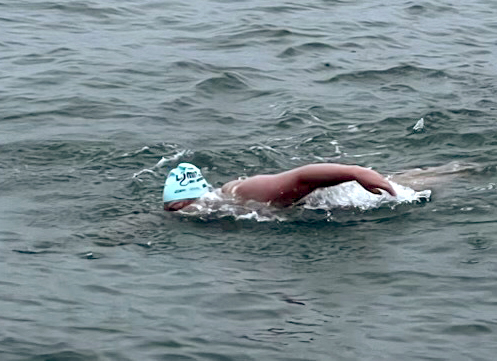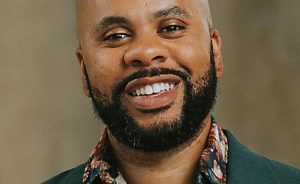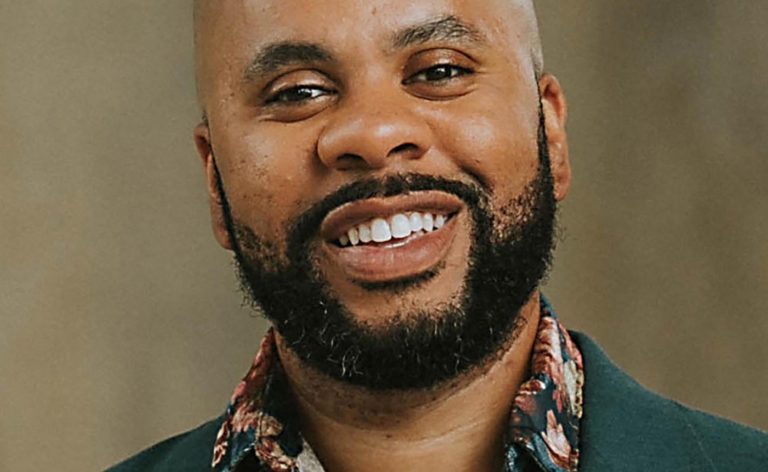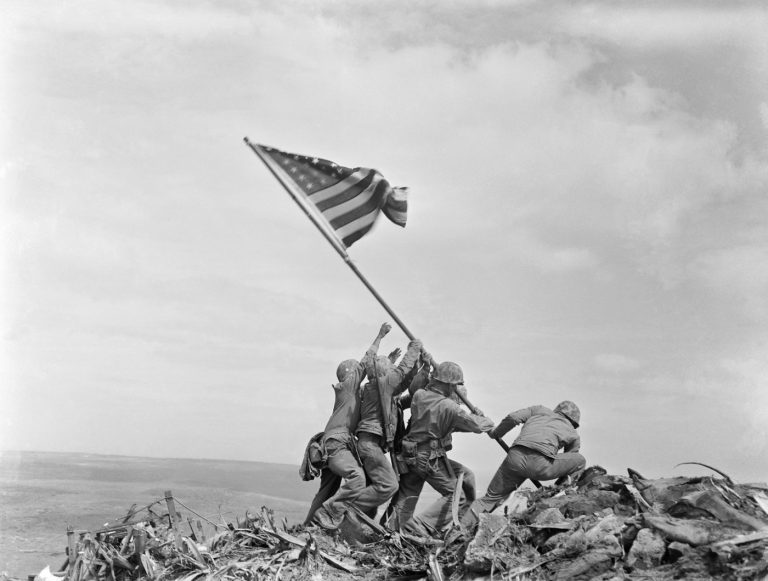A 55-year-old grandmother swam 17 hours across the Gulf of the Farallones this weekend, braving jellyfish, darkness, fog, frigid water and the shark-infested “Red Triangle” to become the first person in history to complete the treacherous outbound route.
For Amy Appelhans Gubser, of Pacifica, Friday was like any other day. She worked her usual 10-hour shift in fetal cardiology at UC San Francisco.
Then at 3:25 a.m. Saturday, without a wetsuit, she jumped off a boat into dark waters under the Golden Gate Bridge and began swimming — stopping only when she reached a bobbing buoy at Southeast Farallon Island, 29.7 miles away, at dusk.
Members of her support team, who monitored her safety from a fishing boat, erupted into cheers.
“When I touched it, I was so grateful. Not just that I had this opportunity to complete this swim, but that it went so flawlessly,” she said Monday after riding her bike to the dentist, her voice still raspy from immersion in salt water.
But in the world of extreme marathon swimming, the miles between the Farallon Islands and San Francisco are reputed to be the toughest in the world — with cold, rough water, ripping winds, swirling currents and hungry carnivores.
Until today, only five people have accomplished this swim. They’ve gone the other direction — from the Farallones to San Francisco, also very challenging because it means timing the tides to get through the Golden Gate. But water gets warmer as they go, and less dangerous.
It took five years of planning for Gubser, who has also crossed Lake Tahoe, Monterey Bay, the Catalina Channel, the Strait of Gibraltar and the notoriously difficult channel between Ireland and Scotland, among other adventures.
To guide her journey, immersed in fog above and murky below the surface from a red tide, she followed the fishing boat Pacific Rival, piloted by Capt. Chad Dahlber. A team of seven other people aboard the vessel, all trained in ocean rescue and cardiopulmonary resuscitation, also supported her.
Food was tossed by ropes into the water. In the event of a shark attack, tourniquets and other first aid equipment were on deck. The U.S. Coast Guard wanted to know the color of her swimsuit — black and white, to mimic a fierce Orca — in case a recovery was needed.
Accolades have poured in from across the global community of “open water” swimming, a sport first inspired by Capt. Matthew Webb’s swim across the English Channel in 1875 and more recently popularized by films such as “Nyad,” which documents Diane Nyad’s extraordinary journey from Havana to Key West.
“Congratulations Amy on this astonishing, world-class feat of cold-water endurance and athleticism,” wrote the Marathon Swimmers Federation.
“Support swimmers” joined her for the first few miles; later, she was accompanied by kayaker John Chapman, who sang upbeat ‘80s tunes.
But her happiest hours were spent alone.
“When I swim, it’s the most freeing time for my mind,” she said, “because it just can slow down. I lose track of time.”
“I find it very peaceful. It’s one of the only times my brain actually calms down,” said Gubser, trained as a pediatric intensive care nurse and who now coordinates high-risk fetal care. “Swimming is effortless for me, easier than walking. It feels like I could go forever.”
Sometimes she counts — reaching 77, then repeating. She makes up poems. She imagines solutions to the world’s biggest problems. She plays songs in her head, often fixating on the same verse over and over.
And she amuses herself with the ocean’s oddities.
“We got swarmed by bats!” she said. “It was so funny. One landed on a crewmate. They came from nowhere. What were they doing there?”
Gubser was taught to swim as a toddler by her mother, a lifeguard. She grew up on Southern California beaches and attended the University of Michigan on a swimming scholarship. Her husband, Greg Gubser, is Deputy Harbor Master at the San Mateo County Harbor.
She trains by swimming many miles a week in the chilly San Francisco Bay with fellow members of the South End Rowing Club at Aquatic Park, with additional training in a Burlingame pool to perfect her technique. She weighs over 200 pounds, a deliberate effort to help fend off hypothermia.
Saturday was chosen because it offered a strong ebb current. With the gravitational tug of a new moon, tides swung from six feet to negative one foot — sending millions of gallons of water rushing through the Golden Gate, launching her out into the Pacific.
And winds were unusually calm, never exceeding seven knots. The water was glassy, without the white caps to battle.
“We waited for the perfect weather,” she said. Once aboard the boat, she ate rice cakes, topped by peanut butter and honey, for energy. She wore only her suit, a cap and goggles.
But before even getting wet, Gubser faced a challenge: a passing container ship. This delayed her start, which had been exquisitely timed to coincide with the optimal tide, currents and time needed to get to safety before sharks’ evening dining hours.
Once in the water, another container ship passed, fewer than 200 feet away.
“I could hear the engines underwater,” she said. “It was honking, and all I could see were these lights in the fog, so I knew it was close. You play ‘Frogger’ with container ships for the first 12 miles, because that’s the shipping lane.”
But then Mother Nature offered an assist. Aboard a ripping ebb tide, Gubser was propelled about one-third of her route in merely four hours.
“Mr. Toad’s Wild Ride,” she joked. She glowed in the dark, wearing a small blue light on her head and a green light on her butt.
Amy Appelhans Gubser of Pacifica became the first person in history to swim from the Golden Gate Bridge to the Farallones on Saturday, May 11, 2024. It took Gubser 17 hours to cover the 29.7-mile distance, reputed to be the toughest marathon swim in the world. (Photo by Sarah Roberts)
Miles out, the tide eased — and she needed to power herself. She gutted out the remaining distance in 13 hours, swimming freestyle the whole way. Every half hour, the crew tossed her containers of three ounces of chicken bone broth, accompanied by a carbohydrate drink for energy. When she felt sleepy, they gave her a caffeine-rich goop.
The jellyfish came in waves, stinging an estimated 20 times.
The water was murky, caused by a red tide algae bloom. Enveloped in fog, “it was almost like being in a sensory deprivation chamber. The sky was gray and the water was brown. I couldn’t see past my fingertips.”
As she approached the Farallon Escarpment — steeply sloped, reaching a depth of over 6,000 feet — the water temperature plunged to 43 degrees.
Worried, her crew saw her skin start to turn pale. They gave her hot chocolate and warm water to pour over her neck and on her hands. But under the rules, she was not allowed to touch the boat.
“I knew that I would feel horrible if I didn’t finish at that point,” she said. “I’ve got kids and grandkids, and I wanted them to be proud of me.”
“I dug deep,” she said. “I wanted to show that, if you put your mind to something, you can do anything.”












